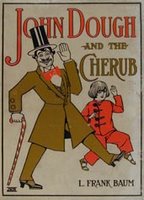Going to See the Incubator Baby
 My presentation on L. Frank Baum's 1906 fantasy John Dough and the Cherub was received warmly on Friday night, and I'm grateful. The topic that seemed to most surprise and intrigue people was the historical basis of Chick the Cherub, the Incubator Baby. That's the small child in pajamas who appears on the right side of the book's cover. With help from Dr. Ray Duncan's neonatology.org, here's more background on incubator babies in early 20th-century America.
My presentation on L. Frank Baum's 1906 fantasy John Dough and the Cherub was received warmly on Friday night, and I'm grateful. The topic that seemed to most surprise and intrigue people was the historical basis of Chick the Cherub, the Incubator Baby. That's the small child in pajamas who appears on the right side of the book's cover. With help from Dr. Ray Duncan's neonatology.org, here's more background on incubator babies in early 20th-century America.
In 1906, incubators for premature babies needing constant warmth were a relatively new thing in American medicine. Though simpler machines had been around for decades, and had been used in hatching chicken eggs, a modern style of incubator made its debut at the Trans-Mississippi Exposition in Omaha, Nebraska, in 1898. "Infants Incubators with Living Infants" proclaimed the sign above the front door of an exhibition building. "A Wonderful Exhibition / Infant Incubators / LIVE BABIES".
This exhibit proved popular enough that an even more substantial hall was set aside for the "INFANT INCUBATORS" at the Pan-American Exposition in Buffalo in 1901. There was also an exhibit at the St. Louis Fair of 1904 and, for many years, at Coney Island in New York and other urban amusement parks and exposition grounds.
Why were premature infants in incubators put on display at fairs rather than nestled in hospitals? First of all, hospitals were just beginning to add departments for mothers and newborns. A century ago, well over 90% of American babies were still being born in the family home. Therefore, as long as a baby had to be driven somewhere for extra care, it might as well be an exposition. The exhibits let the doctors promoting the new incubators maximize the number of people who learned about them. And they helped pay for themselves by attracting crowds.
The result was a surge of public interest in "incubator babies" in the first decades of the 1900s. The fairs, of course, encouraged such coverage as "The Incubator Baby and Niagara Falls" (Cosmopolitan, 1901); "Three Tiny Girls in the Incubators" (Buffalo Evening News, 17 July 1901); and "The Incubators at Wonderland Park" (Minneapolis Journal, 20 May 1905). In 1906, the same year Baum published John Dough and the Cherub, the humorist Ellis Parker Butler published a comic novel called The Incubator Baby, which had run nationally in magazines the year before.
Reading that coverage at neonatology.org puts me in mind of more recent articles on "test tube babies," prenatal surgery, and speculation on human cloning, as well as long-ago writing about anesthesia in childbirth. Most of these writers seem happy for the infants and parents who have been helped by the new technology, but express an almost atavistic worry about whether changing such a fundamental biological process can be healthy, physically and morally.
Baum's character of Chick shows no ill effects of being raised in/by an incubator, aside from a worry about eating anything besides oatmeal and cream. (When stranded on a desert island, Chick eats fruit with no digestive difficulty, so even this worry might be overblown.) Of course, Baum never mentions whether Chick is male or female. In the nature v. nurture debate about what determines a person's gender expectations and behavior, Baum seems to come down solidly on the nurture side, writing Chick to be as genderless as an incubator itself.


No comments:
Post a Comment